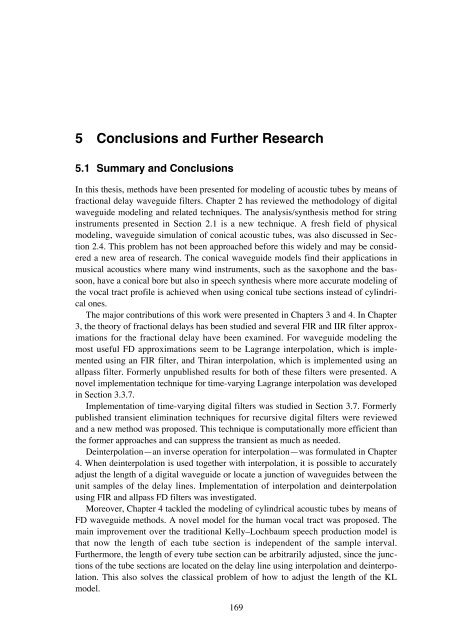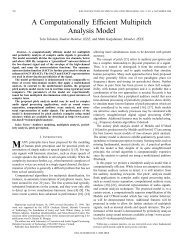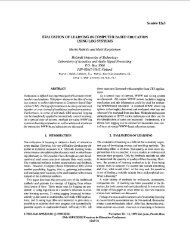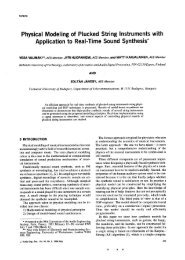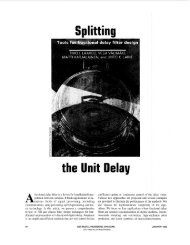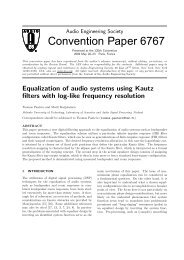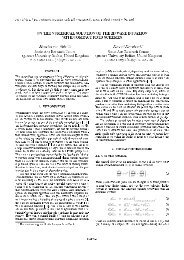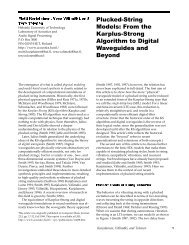Chapter 5. Conclusions and Further Research
Chapter 5. Conclusions and Further Research
Chapter 5. Conclusions and Further Research
You also want an ePaper? Increase the reach of your titles
YUMPU automatically turns print PDFs into web optimized ePapers that Google loves.
5 <strong>Conclusions</strong> <strong>and</strong> <strong>Further</strong> <strong>Research</strong><br />
<strong>5.</strong>1 Summary <strong>and</strong> <strong>Conclusions</strong><br />
In this thesis, methods have been presented for modeling of acoustic tubes by means of<br />
fractional delay waveguide filters. <strong>Chapter</strong> 2 has reviewed the methodology of digital<br />
waveguide modeling <strong>and</strong> related techniques. The analysis/synthesis method for string<br />
instruments presented in Section 2.1 is a new technique. A fresh field of physical<br />
modeling, waveguide simulation of conical acoustic tubes, was also discussed in Section<br />
2.4. This problem has not been approached before this widely <strong>and</strong> may be considered<br />
a new area of research. The conical waveguide models find their applications in<br />
musical acoustics where many wind instruments, such as the saxophone <strong>and</strong> the bassoon,<br />
have a conical bore but also in speech synthesis where more accurate modeling of<br />
the vocal tract profile is achieved when using conical tube sections instead of cylindrical<br />
ones.<br />
The major contributions of this work were presented in <strong>Chapter</strong>s 3 <strong>and</strong> 4. In <strong>Chapter</strong><br />
3, the theory of fractional delays has been studied <strong>and</strong> several FIR <strong>and</strong> IIR filter approximations<br />
for the fractional delay have been examined. For waveguide modeling the<br />
most useful FD approximations seem to be Lagrange interpolation, which is implemented<br />
using an FIR filter, <strong>and</strong> Thiran interpolation, which is implemented using an<br />
allpass filter. Formerly unpublished results for both of these filters were presented. A<br />
novel implementation technique for time-varying Lagrange interpolation was developed<br />
in Section 3.3.7.<br />
Implementation of time-varying digital filters was studied in Section 3.7. Formerly<br />
published transient elimination techniques for recursive digital filters were reviewed<br />
<strong>and</strong> a new method was proposed. This technique is computationally more efficient than<br />
the former approaches <strong>and</strong> can suppress the transient as much as needed.<br />
DeinterpolationÑan inverse operation for interpolationÑwas formulated in <strong>Chapter</strong><br />
4. When deinterpolation is used together with interpolation, it is possible to accurately<br />
adjust the length of a digital waveguide or locate a junction of waveguides between the<br />
unit samples of the delay lines. Implementation of interpolation <strong>and</strong> deinterpolation<br />
using FIR <strong>and</strong> allpass FD filters was investigated.<br />
Moreover, <strong>Chapter</strong> 4 tackled the modeling of cylindrical acoustic tubes by means of<br />
FD waveguide methods. A novel model for the human vocal tract was proposed. The<br />
main improvement over the traditional KellyÐLochbaum speech production model is<br />
that now the length of each tube section is independent of the sample interval.<br />
<strong>Further</strong>more, the length of every tube section can be arbitrarily adjusted, since the junctions<br />
of the tube sections are located on the delay line using interpolation <strong>and</strong> deinterpolation.<br />
This also solves the classical problem of how to adjust the length of the KL<br />
model.<br />
169
170 Discrete-Time Modeling of Acoustic Tubes Using Fractional Delay Filters<br />
The FIR filter implementation of an FD junction is perhaps more intuitive than the<br />
allpass filter approach. This is due to the equivalence of the coefficient vector <strong>and</strong><br />
impulse response of the FIR filter. In Section 4.3 it was shown how the FD KL junction<br />
can be efficiently implemented by FIR filters when half of the multiplications are combined.<br />
Analysis of approximation errors due to the FD filters was also investigated. The<br />
reflection <strong>and</strong> transmission functions of the FD KL junction were derived <strong>and</strong>, as an<br />
example, the magnitude response of a two-tube model was studied when first <strong>and</strong> thirdorder<br />
Lagrange interpolating filters were used.<br />
Modeling of a side branch at an arbitrary point of a cylindrical tube was also studied<br />
in Section 4.4. The main application considered was simulation of finger holes of<br />
woodwind instruments. Another potential application for this structure is waveguide<br />
modeling of the connection of the human oral <strong>and</strong> nasal tract.<br />
In Sections 4.6 <strong>and</strong> 4.7, allpass filter models for fractional delay junctions of two <strong>and</strong><br />
three tubes were developed. These structures have not been studied in the DSP literature<br />
before.<br />
<strong>5.</strong>2 Suggestions for Future Work<br />
This thesis studies the theoretical possibilities of fractional delay waveguide modeling<br />
of the acoustics of wind instruments <strong>and</strong> the human vocal tract. There are plenty of<br />
practical applications for the results of this study. Future work includes development of<br />
an FD waveguide model of a finger hole in a conical tube, <strong>and</strong> also application of the<br />
FD techniques to other waveguide algorithms. For example, in waveguide synthesis of<br />
plucked string instruments, the pluck position could be controlled arbitrarily using deinterpolation.<br />
Fractional delay filtering techniques can as well be applied to two-dimensional<br />
waveguide systems that model a vibrating membrane or three-dimensional systems<br />
that can be used, e.g., for room simulation. Digital reverberators, flangers, <strong>and</strong><br />
phasers are based on delay lines <strong>and</strong> thus the utilization of FD techniques could offer<br />
additional possibilities in terms of improved accuracy or exciting new timbres.<br />
The interpolated waveguide tube model can be used for creating a new kind of<br />
articulatory speech synthesizer. This approach seems to be well motivated. For example,<br />
Mrayati et al. (1988) have proposed a speech production model where the vocal<br />
tract is divided into segments of different length. The FD waveguide techniques could<br />
be used for implementing such a model.<br />
A fascinating future research project is to implement time-varying fractional delay<br />
waveguide modelsÑespecially using allpass filters. Maeda (1977), Strube (1982), <strong>and</strong><br />
Liljencrants (1985) have proposed techniques that allow the use of time-varying reflection<br />
coefficients in digital waveguide tube models. A new transient elimination method<br />
was introduced in this work, <strong>and</strong> using it together with formerly known techniques of<br />
time-varying waveguide modeling, it should be possible to realize well-behaving models,<br />
whose properties can change as they are playing.<br />
Another interesting field of further research is measurement of musical instruments<br />
<strong>and</strong> estimation of parameters of a digital waveguide model (VŠlimŠki et al., 1995c;<br />
Karjalainen et al., 1995b). Measurements are also needed if the radiational properties of<br />
sound sources are to be incorporated in a digital waveguide model (Huopaniemi et al.,<br />
1994; Karjalainen et al., 1995a).<br />
Design of FIR fractional delay filters can be considered a well-exploited problem.
<strong>Chapter</strong> <strong>5.</strong> <strong>Conclusions</strong> <strong>and</strong> <strong>Further</strong> <strong>Research</strong> 171<br />
The same is not true for IIR FD filters; merely a subclass of recursive FD filters, the allpass<br />
filters, has been thoroughly studied (Laakso et al., 1994). The author is aware of<br />
only one study on fractional delay approximation using pole-zero filters that are not allpass<br />
filters (Tarczynski <strong>and</strong> Cain, 1994).<br />
For real-time applications, it may be interesting to study fractional delay filtersÑ<br />
both FIR <strong>and</strong> IIRÑthat produce a very small total delay. The FIR filters discussed in<br />
this study have a total delay of approximately N/2 samples (where N is the filter order),<br />
since they interpolate between their centermost state variables. Also, the allpass filters<br />
studied here have a large total delay, typically about N samples.<br />
Fractional delay filters have started to become popular in several areas of digital signal<br />
processing (see the very beginning of <strong>Chapter</strong> 3 for references). There is no doubt<br />
that many more signal processing problems can be solved more efficiently, or better<br />
than before, when someone realizes that fractional delays are of help. Potential future<br />
research projects in this area are, for example, irrational sampling rate conversion or<br />
time-varying fractional resampling of discrete-time signals using allpass or recursive<br />
FD filters.<br />
The above mentioned two new problems are also examples of applications where the<br />
new transient elimination method proposed in this thesis may be employed. Other possible<br />
uses can be found in many different kinds of filtering problems where the parameters<br />
of a recursive filter need to be changed during operation, such as in equalization of<br />
audio signals.<br />
Nowadays it is not feasible to use very high-order FD filters in real-time applications,<br />
such as in waveguide synthesisÑat least when only a single DSP processor is<br />
available. However, as the computing power of signal processing hardware increases it<br />
will become possible to utilize higher-order interpolators <strong>and</strong> deinterpolators <strong>and</strong> still<br />
run the application in real time. This implies that the difference between the practical<br />
FD approximation <strong>and</strong> the ideal fractional delay will be reduced. At the same time it<br />
will become more <strong>and</strong> more realistic to talk about virtually continuous processing of<br />
discrete-time signals <strong>and</strong> systems.


